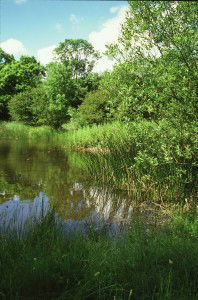Our best freshwaters are dwindling
23rd November 2015
Our re-visit to beautiful National Pond Survey sites was tinged with sadness as many plants have been lost.
Twenty-five years ago, when Freshwater Habitats Trust was in its infancy, we undertook the first national survey of ponds in Britain. We collected plants and invertebrate data from over 150 ponds in some of the UK’s most beautiful places –everywhere from shallow serpentine pools on the Lizard to the wildwood lochans of Abernethy Forest in Scotland.
This summer our Technical Director, Penny Williams who surveyed the plants in our original survey, returned to 29 survey sites as a volunteer for our HLF funded People, Ponds & Water project. It is was an important piece of information gathering because there are incredibly few long-term data sets for freshwater habitats, and none look at biodiversity changes in our highest quality ponds in National Nature Reserves, SSSIs and National Parks.
 A pond at Castor Hanglands (c) Natural England/Paul Glendell 1999
A pond at Castor Hanglands (c) Natural England/Paul Glendell 1999
The survey results showed that some ponds had retained or increased their richness over the last 25 years –like the wonderful pools in Castor Hanglands NNR near Peterborough and Brown Moss in Shropshire. Unfortunately, though this wasn’t typical. Most ponds had lost a significant number of plant species, with the average a staggering 19% decline: from 26 species per pond in the 1990s, to 21 in the same ponds today. Submerged aquatic plants like Water Milfoils were particularly vulnerable and declined significantly by over 30%. Uncommon and rare species were also badly hit: with many ponds losing their most uncommon plants like Water Violet, Frog-bit and Tubular Water-dropwort.
We haven’t yet completed analysis of the data – but provisional results suggests that ponds fared best if they were located in extensive semi-natural landscapes – like moorland grassland, particularly if there were many other ponds and wetlands nearby. The worst hit were small ponds and pools on heathlands that were once grazed, but have now become tree covered and shaded.
The results from these high quality ponds in protected areas closely mirror findings from our previous work with CEH in the wider landscape, which showed that the number of plants in typical lowland countryside dropped by 20% between 1996 and 2008.
What we’ll do now
These are worrying findings, and we need to check more of the 150 National Pond Survey sites next summer to see if this pattern holds true more widely. We’ll also try to get research funded to re-survey the invertebrate communities as well as the plants in the ponds. In the meantime it’s important to make the most of the data we already have, so we’ll report the results to Natural England where we hope it will contribute to Biodiversity 2020 reporting, and aim to use the data within the UK NGOs State of Nature reports to be published in 2016. If you want to see the data for yourself, the information will be available on the PondNet website in the new year.
Find out more
- Take a look at the Countryside Survey Pond Report for details on the state of ponds in 2007.
- Find out more abut the National Pond Survey method.
